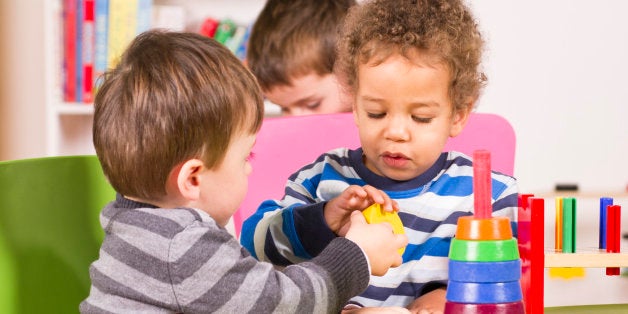
My child won't share. The issue will either come up between siblings or when your child starts school. All of a sudden they can't keep all the toys to themselves and it's an emotional disaster.
It's pretty inevitable that teaching a child about sharing is going to be something unavoidable. A child who has never had to share before with a sibling or group of friends might find it odd that all of a sudden they have to let others use their toys.
They might also find it odd that taking a toy from another little boy or girl, without asking, is not a very nice thing to do, nor is it going to be greeted with joy from the other child. Sharing can be tough for adults who do know how the concept works, but even more so for a child that is being introduced to the notion for the first time.
Sharing for a toddler is like someone riding the train for the first time. ""So here's how it goes," my friend told me. "You look at the board, try and find your train, find the track number and when the board changes, you run like the wind get to your train before it leaves without you." When I heard that, on my first trip out of New York City, I said. "What the heck is that all about?" Well, that's sort of like a child being told for the first time, that the blocks they have been building with for the past hour, which is now the most amazing tower ever, must be totally disassembled or in most cases plowed down, so someone else can take them away and build their own tower.
When you introduce a child to that notion for the first time, I bet you will get the same dumbfounded look as I had in the train station, or even worse a combo of crying and screaming.
So how do we introduce sharing? A concept that really does seem like an awfully horrible practice to a toddler? Here are a few tips to help you navigate.
1. MODEL
A few weeks before your child starts a playgroup or preschool begin modeling sharing at home.
Bring out a few toys and let your child choose what they would like to play with. Then you choose something to play with. After a few minutes, ask your child if they would like to share your toys and play with you. Show them how you share by giving them a few of your blocks. Then ask them to share with you, by choosing a few blocks to put into your pile.
This may seem simple, but this is the first step in helping your child become comfortable giving something to someone else. Thank your child for sharing, and after a minute or two (not much longer) give the blocks back and let them know that you are done playing with them and would like to give them back. Ask them to give back your blocks when they are ready.
You may have to try this a number of times before your child becomes trusting enough of the concept and confident that they will get their blocks back.
2. SHARE VISUAL CLUES AND SET LIMITS
Bring out the blocks again and tell your child that you are going to practice sharing again today. Bring out two different bins of blocks or group of trains or dolls, and make sure you have a simple clock with numbers and hands available. Start by playing the sharing game for 10 minutes. Tell your child for example, that when the big hand gets to the 2 you are going to share your toys with each other. "Mommy will play with your toys and you will play with my toys. When the big hand moves to the 6 we will share again. Mommy will give you back your toys and you will give Mommy back hers." Remind your child that if they get upset during the sharing time, to watch the clock and remind you when it's time to share again. Using the visual clues will help them to manage expectations.
3. MAKE SOME EGGS
Not really, but do use an egg timer to let your child know when it is time to give someone else a turn. This technique is especially helpful when your child begins to play in a group. When a group of children are playing together and they all want to play with the same toys, tell them that they will all get a turn but they have to wait for the timer to buzz. Set the timer for 10-minutes and when the egg timer buzzes, everyone has to give their toy to someone else to try it out. The kids will often find it fun and exciting to wait for the buzz and enjoy the anticipation of gaining something new and fun to play with.
Do you have any other great ideas to help your child learn about sharing? Comment and share with us!
Next Week: Help! My Child Won't Eat Anything.